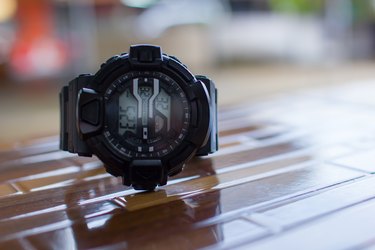
Casio's rugged G-Shock watches are built around the simple idea that a watch should survive for years, no matter what. The series launched in 1983, and Casio sold its 100 millionth by 2017, so clearly many customers agreed. Most G-Shocks use buttons for time setting, like other watches, but some models offer simpler options.
G-Shock Button Arrangement
Video of the Day
G-Shock watches have four or five buttons that control their functions. At the top left and right are the A and B buttons, and at the bottom left and right are the C and D buttons. Some models add a fifth button midway down the side, which becomes the C button. On those models, the bottom left and right buttons become D and E. Others add the fifth button at the bottom, where it's labeled as L.
Video of the Day
Manual time setting uses the top and bottom four.
Setting Your G-Shock Manually
Begin in standard or "timekeeping" mode. To enter time-setting mode, find the A button at the top left of the dial and hold it down for a few seconds.
On many models, the message ADJ appears and then changes to SET when you let go of the button. Current models of G-shock change the time zone automatically, so the first thing you are prompted to do is choose a city code for where you live or at least for a city in the same time zone. Use the right-side top and bottom buttons to move east or west until you find the correct city and then press the lower-left button to select it and move on to the next setting.
You are asked to indicate whether it's daylight saving time currently and then are cycled through choosing a 12-hour or military-style 24-hour display format, and setting the time, date, month and day of the week. After you've chosen all the appropriate settings, press the A button to return to normal timekeeping mode. Some models break home-city selection and time-setting into different sequences with slight variations in the screen messages and button presses.
Using Atomic Timekeeping
Some G-Shock models are capable of keeping themselves updated. Models with what Casio calls "atomic timekeeping" receive a radio signal from one of six atomic clocks located around the world. To give the watch an opportunity to set itself, take it off and leave it in a windowsill in an area that's free of indoor or outdoor obstructions or any equipment that generates electric signals.
Ideally, it should find a signal and self-set in 12 minutes or less, but leaving it overnight is even better. Don't use the watch while it's listening for a signal.
Setting Time Through Your Phone
If you have a Bluetooth-enabled G-Shock, you can pair it with a smartphone and use Casio's G-Shock Connected app or the older G-Shock+ app. Both are available for Android and iOS.
For the Connected app, make sure the phone's Bluetooth is turned on and then place it within three feet of the watch. Tap the Connected icon to launch the app. While the second hand is pointed away from the Bluetooth logo on the watch face, press and hold the lower-left button for about 4 seconds. The second hand will point to the Bluetooth logo, showing a connection. Whenever you pair the phone and the watch, the G-Shock checks the phone's system time and updates accordingly.
For older models using the G-Shock+ app, tap to start the app and then tap the Discover G-Shock button on the screen. Hold down the pairing button on your watch – top left or bottom right, depending on the model – until the watch's model number appears on your phone screen. Tap the model number, and a passkey number appears on the watch. Enter it on the app to complete the pairing process.
Finding Your G-Shock Manual
These G-Shock instructions apply to most current models, but older models may vary. Each G-shock watch has a four-digit module number on the back that identifies the version of the company's software that's in the watch. To find specific instructions for your G-shock, enter the module number into the search box on the company's support page for timepieces.
- Casio Support: Operation Guide 5522
- Casio Support: Operation Guide 5081
- Casio Support: Operation Guide 5302
- Casio Support: Appropriate Signal Reception Location
- Casio: G-Schock Ships 100-Millionth G-Shock Shock-Resistant Watch
- Casio Support: G-Shock+ Ver 1.1 Setup Guide
- Casio Support: Watch Manual Archives